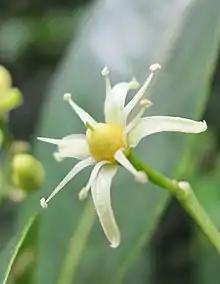Acronychia pedunculata
Acronychia pedunculata is a large shrub or small tree of the understory, gaps and fringes of low country and lower hill tropical forests of tropical Asia. Leaves: elliptic to subolong, often with tapered base. Twigs more or less angular, glabrous. Flowers: greenish white; I-acillary, corymbose panicles, about 14 mm (0.6 in) across in inflorescences of 4–24 cm (2–9 in) wide. Flowering: February–April, July–August. The fruits are cream to brownish yellow drupes, slightly angled, 0.5–1.5 cm (0.2–0.6 in) in diameter with a short apiculate tip. Leaves and fruits, and other parts of the plant, contain aromatic oils with a resinous scent. In Sri Lanka, the flowering time is February–April and July–August.[1][2]
| Acronychia pedunculata | |
|---|---|
 | |
| At Udawattakele, Kandy, Sri Lanka | |
| Scientific classification | |
| Kingdom: | Plantae |
| Clade: | Tracheophytes |
| Clade: | Angiosperms |
| Clade: | Eudicots |
| Clade: | Rosids |
| Order: | Sapindales |
| Family: | Rutaceae |
| Genus: | Acronychia |
| Species: | A. pedunculata |
| Binomial name | |
| Acronychia pedunculata (L.) Miq. | |
| Synonyms | |
| |
Distribution
South and Southeast Asia from India & Sri Lanka to South China & Taiwan, Indochina, Malesia & Papua New Guinea.[3]
Local names
Sinhala: Ankenda (අංකෙන්ද). Chinese: Jiangzhenxiang (降真香). Nepali: Paolay. Assamese: Laojan. Tamil & Malayalam: Mutta-nari.
Uses
Extracts of its leaves, bark, stems and fruits are widely used in herbal medicinal applications against sores, scabies and intestinal infections, due to their antifungal and antimicrobial properties. Contains aromatic, essential oils, which are used in China for making perfumes. The ripe fruit is edible and has a sweet acidic flavor. Unripe fruits have a strongly astringent, resinous taste. The roots are used as a fish-poison in southern Vietnam.[4][5][6][7] In India the wood is used for carving, poles, house construction and making the charcoal preferred by goldsmiths. And the tender leaves are used in salads and as a condiment.[8]
Its wood, called lakawood (a term covering a few different plants), is also used in incense production.[9] It is particularly favoured by Taoist practitioners who are forbidden from using sandalwood.
References
- D. Dassanayake and F.R. Fosberg, A Revised Handbook to the Flora of Ceylon Vol. V, New Delhi, 1985, p. 412–13
- M Ashton, S Gunatilleke, N Zoysa, MD Dassanayake et al., Field Guide to the Common Trees and Shrubs of Sri Lanka, Colombo 1997, Section 78-1, p.333.
- D. Dassanayake and F.R. Fosberg, A Revised Handbook to the Flora of Ceylon Vol. V, New Delhi, 1985, p. 412–13
- S.K. Rodrigo, U.L.B. Jayasinghe and B.M.R. Bandara, 'Antifungal, Antioxidant and Cytotoxic Activity of Acronychia pedunculata and Adenanthera pavonina' in Proceedings of the Peradeniya University Research Sessions, Sri Lanka, Vol.12, Part I, 30 November 2007.
- Lesueur D, De Rocca Serra D, Bighelli A, Hoi TM, Thai TH, Casanova J., 'Composition and antimicrobial activity of the essential oil of Acronychia pedunculata (L.) Miq. from Vietnam,' in Natural Product Research: Formerly Natural Product Letters, 1478-6427, Volume 22, Issue 5, 2008, Pages 393 – 398.
- C. P. Li, Chinese Herbal Medicine, U.S. Department of Health, 1974, p.49.
- 'The William Gardener Collection of Chinese Medicinal Plants,' Edited by Anthony C. Dweck, 1995, pp.11–12. At http://www.dweckdata.com/Published_papers/William_Gardener.pdf (Accessed: 7.9.2010).
- Ambasta SP (Ed.), "The Useful Plants of India", 1986. CSIR. New Delhi, pp 1-918.
- Victor H Mair; Liam Kelley (30 September 2015). Imperial China and Its Southern Neighbours. ISEAS Publishing. pp. 222–228. ISBN 978-9814620536.